Anic:
Old Indian Defence A55
1.d4 Nf6
2.c4 d6 3.Nc3 Nbd7
4.e4 e5 5.Nf3 Be7
6.Be2
0-0 7.0-0 c6 8.Qc2
a6 9.Rd1Qc7
10.Bg5 Re8
11.Rac1 Qb8
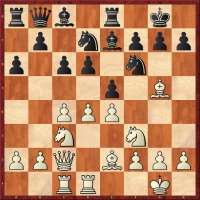 |
|
The author gives an insight into an opening
which has perhaps unjustly had a not very
flattering reputation, but which is well-suited
for a counter-attack based on a solid position.
Until now 11...Qb8
has rarely been played, but GM Anic’s analysis
is encouraging. |
Knaak: Nimzowitsch Defence B00
1.e4 Nc6
3.d4 d5 3.Nc3
dxe4 4.d5 Nb8
|
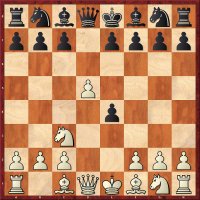 |
|
Till now 3.Nc3
has been considered as the main move to give
White an advantage. But according to Rainer
Knaak’s investigations Black can expect to
achieve safe equality with 3...dxe4 4.d5 Nb8.
Therefore, both 3.e5 and 3.exd5 should be
preferred to 3.Nc3. |
Kritz: Caro-Kann B12
1.e4 c6 2.d4 d5 3.e5 Bf5
4.Nf3
e6 5.Be2
c5 6.Be3
 |
|
In the opinion of Leonid Kritz, nowadays only
3.e5 gives White any prospects of achieving a
slight advantage against the Caro-Kann. In that
variation, the line examined here is of
particular importance. The author shows that
neither 6...Qb6
nor 6...cxd4 equalises fully. |
Grivas: Sicilian B33
1.e4 c5 2.Nf3 Nc6
3.d4 cxd4 4.Nxd4 Qb6
5.Nb3 Nf6
6.Nc3
e6 7.Be3 Qc7
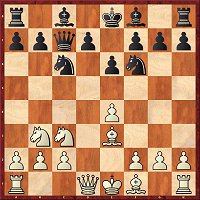 |
|
In the fourth part of his examination of the
Grivas-Sicilian 4...Qb6
our Greek author turns above all to the Dionysos
Variation, which starts from the diagram with
8.f4. After 8...Bb4
9.Bd3 Bxc3+
10.bxc3 d6 11.0-0 e5 Black has a satisfactory
game. |
Karolyi: Sicilian B92
1.e4 c5 2.Nf3
d6 3.d4 cxd4 4.Nxd4 Nf6
5.Nc3
a6 6.Be2
e5 7.Nb3 Be7
8.0-0 0-0 9.Kh1Nc6
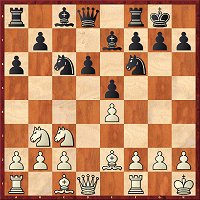 |
|
White’s king move is in itself a subtle one,
since the standard move 9...b5 is not so good on
account of 10.a4. But 9...Nc6
has proved its worth and Black need fear neither
10.f3 nor 10.f4, and certainly not any moves
with anything other than the f-pawn. |
Ftacnik: Sicilian B96
1.e4 c5 2.Nf3
d6 3.d4 cxd4 4.Nxd4 Nf6
5.Nc3
a6 6.Bg5
e6 7.f4 Nc6
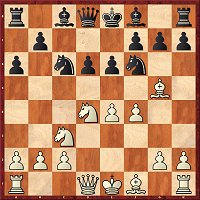 |
|
The article comes to two conclusions: 8.e5 h6 9.Bh4
is no longer attractive for White, because
9...dxe5 goes into an ending which has seen good
results for Black. But after 8.Nxc6
bxc6 9.e5 h6 10.Bh4
g5 11.fxg5 Nd5
it can also come down to an ending, but this
time one which is favourable to White. |
Bojkov: Ruy Lopez C92
1.e4 e5 2.Nf3 Nc6
3.Bb5
a6 4.Ba4 Nf6
5.0-0 Be7
6.Re1
b5 7.Bb3
d6 8.c3 0-0 9.h3 Rb8
10.d4 exd4 11.cxd4 d5
 |
|
There is no doubt that the surprising 9...Rb8
and 11...d5 set White some problems. But if the
latter knows what he is doing, then Black’s
setup should be somewhat dubious. In any case,
that is what has been proved by recent
correspondence games. |
Stohl: Ruy Lopez C92
1.e4 e5 2.Nf3 Nc6
3.Bb5
a6 4.Ba4 Nf6
5.0-0 Be7
6.Re1
b5 7.Bb3
d6 8.c3 0-0 9.h3 Bb7
10.d4 Re8
11.Nbd2 Bf8
12.a4
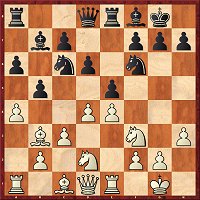 |
|
The Zaitsev Variation which Igor Stohl has
examined is clearly different from many versions
of the Closed Ruy Lopez, because in it the
position is often opened rapidly. In the
critical long main variation Black seems to be
able to do quite well. |
Postny: Slav Defence D18
1.d4
d5 2.c4 c6 3.Nf3 Nf6
4.Nc3
dxc4 5.a4 Bf5
6.Nh4
e6 7.Nxf5
exf5 8.e3 Bb4
9.Bxc4
0-0 10.0-0 Nbd7
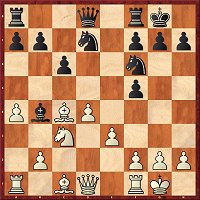 |
|
This article is first of all about the variation
6.Nh4
e6, which hardly leaves White with any choices
on the route to the position in the diagram. But
it can also be reached via 6.e3 e6 7.Bxc4 Bb4
8.0-0 0-0 9.Nh4 Nbd7
10.Nxf5
exf5. Postny has a lot of interesting
conclusions for you to study. |
Kuzmin: Catalan E01
1.d4 Nf6
2.c4 e6 3.Nf3
d5 4.g3 Bb4+
5.Bd2 Bd6
6.Bg2
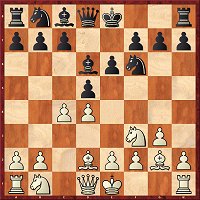 |
|
In the Catalan the black bishop usually moves to
e7 – no matter whether it first delivers a check
on b4 or whether it goes there directly. But why
not to d6? Alexey Kuzmin presents the latest
state of affairs in this still quite new setup. |
Krasenkow: Queen's Indian Defence E12
1.d4 Nf6
2.c4 e6 3.Nf3
b6 4.a3 Bb7
5.Nc3
d5 6.cxd5 Nxd5
7.Qc2 Nxc3
8.bxc3 Be7
9.e4 0-0 10.Bd3
c5 11.0-0
 |
|
In the last part of his article on the Petrosian
System Michal Krasenkow analyses the position in
the diagram which is the one the top players
most often reach. Even if an advantage for White
cannot be proved on all fronts, the positions
which are reached are interesting and well
suited to playing for the full point. |
Schipkov: King's Indian Defence E81
1.d4 Nf6
2.c4 g6 3.Nc3 Bg7
4.e4 d6 5.f3 0-0 6.Be3
c5 7.Nge2 Nc6
8.d5 Ne5
9.Ng3
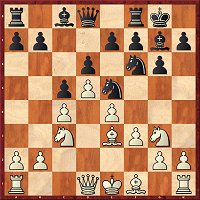 |
|
There is no doubt that 6...c5 has turned into
the greatest test of the Sämisch System.
Nowadays it is thought that declining the pawn
sacrifice gives better chances of achieving an
opening advantage and Boris Schipkov shows you
how to go about that. |